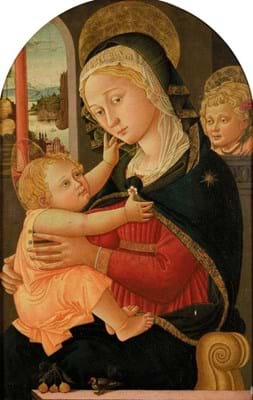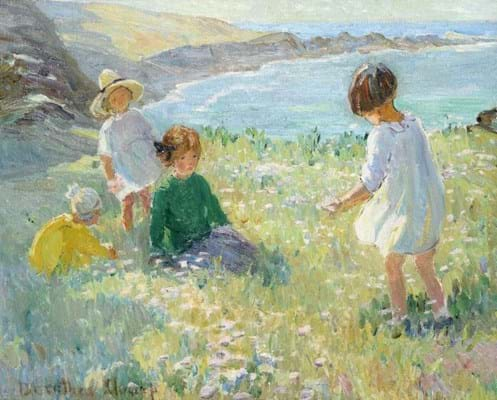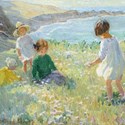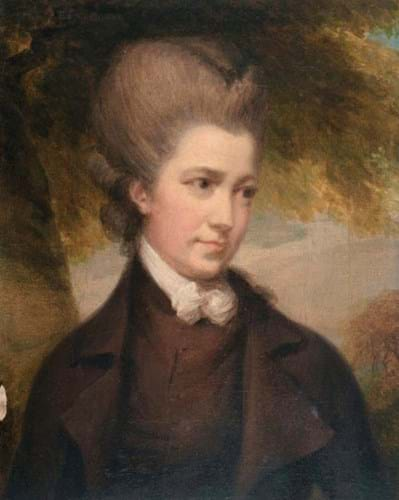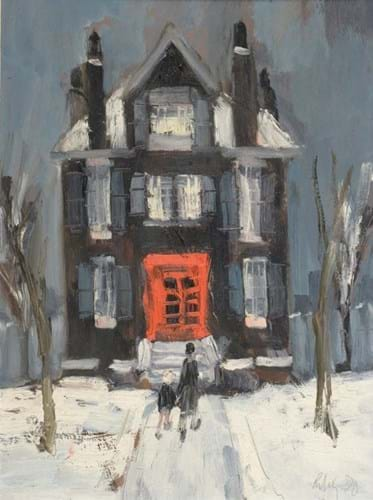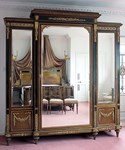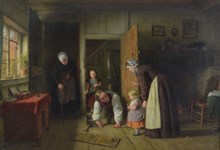This was true of North Yorkshire saleroom Tennants (20% buyer’s premium), which offered a collection of continental Old Masters and other antiques from a nine-bedroom house in Essex on November 18.
Le Pavilion, which had been in the same family since 1938 and is currently on the market for £7.5m, was formerly the principal dwelling on the Shortgrove Estate. This sprawling property was originally built in the 16th century, with gardens and surrounding parkland designed by Capability Brown.
With the help of appealing estimates and an Old Master sleeper, the 10-lot picture group contributed just under £230,000 to the bottom line.
Over half the total came from a 15th century oil on panel of the Madonna and Child, which shed its £6000- 9000 guide to sell for £135,000 to an Italian buyer on the phone.
Getting Lippi
The 2ft 7in x 19½in (79 x 50cm) arched top work had been catalogued as in the ‘manner of Filippo (Filippino) Lippi (c.1406-69)’.
Filippo Lippi (c.1406-69) was a renowned Quattrocento Florentine painter and Carmelite priest, who at one time enjoyed the patronage of the powerful Medici family. His son Filippino Lippi (1457-1504) was also an important painter, having trained both under his father as well as later in Botticelli’s studio.
The oil at the Yorkshire auction shows a chubby Christ on Mary’s lap, the face of John the Baptist over Mary’s left shoulder, a ledge painted with cherries (a symbol of paradise) and a goldfinch, the Christian symbol associated with Christ’s Passion and his crown of thorns.
Not only was the oil painting in “extraordinarily good condition” but it was also deemed to be of the period, according to Tennants. Given the demand that emerged, it certainly seems likely that bidders detected a strong link to 15th century Florence in the composition.
Another high price from Le Pavilion was a Flemish portrait catalogued as by the ‘Workshop of Peter Paul Rubens’ and thought to depict the artist’s sister-in-law, Susanne Fourment. Also bringing competition, it bettered a £25,000-40,000 guide to sell for £65,000.
A multi-estimate sum was achieved for an accomplished copy of Thomas Gainsborough’s (1727-88) portrait of a middle-aged Georgiana, Countess Spencer, wearing a riding habit.
Gainsborough’s finished autograph version was painted in 1781 and was intended as a wedding present from the sitter to her son, who married Lady Lavinia Bingham in the same year. A slightly larger unfinished version hangs at Chatsworth House.
Catalogued as ‘after’ Gainsborough, the 8½ x 6½in (22 x 17cm) work had passed through Christie’s in 1935. It took £12,000 against a £300-500 estimate.
Other sale sources
Outside the Le Pavilion consignment, Old Master portraits from a variety of other sources included in the Autumn Fine Art Sale also drew keen bidding.
Among the stand-out entries was a privately consigned early English School portrait of a young lady, catalogued as by a ‘follower of Hans Eworth (c.1520-74)’.
The sitter, wearing a French cap, ruff and ermine trimmed overcoat, is reputedly Elizabeth I and bears similarities to other well-known early portraits of the monarch, including one in the National Portrait Gallery and The Clopton Portrait, in private ownership.
This work was less refined than both of those, however, and had notable differences including the omission of ‘The Mirror of France’, a large square cut jewel worn on a double chain that had belonged to Elizabeth’s father, Henry VIII. It sold to the London trade at £7500 against a £2500-4000 estimate.
Elsewhere, Tennants secured several pieces from the contents of Shortflatt Tower in Northumberland, a mid-13th century fortified keep that has been in the same family since the 18th century.
The pictures related to one of its occupants, Edward Dent, who had been a renowned greyhound trainer and breeder. A pair of paintings by John Charlton (1849-1917) depicting Dent and some of his legendary coursing greyhounds, drew strong competition, topping their guides to sell to the same private buyer at £10,000 and £6000.
Breast value
The Modern British section at Tennants exemplified the continuing confidence for established Northern artists.
Leading the field was a busy beach scene by popular Liverpudlian artist Brian ‘Braaq’ Shields (1951-97), cheekily called I’ve just seen my first pair of “tits”. It sold within estimate for £17,000.
All five lots by Shields sold strongly, including a quartet of market-fresh pencil and crayon studies of the painter and other family members as children, which had been purchased directly from Braaq. They beat guides of £2000- 3000 to sell for £7000 and £7500 respectively.
A trio of works by Mancunian artist Harold Riley (b.1934) also drew decent bidding. A privately consigned 15 x 11in (38 x 28cm) oil on board titled The Red Door from 1970 more than doubled its top guide to sell to a UK private buyer at £13,000.
Paintings by fellow Mancunian Arthur Delaney (1927-87) and a group of fresh works from the estate of Pennine painter Peter Brook (1927-2009) sold strongly, making sums in the mid-four figures.
Dorothea's daisies
However, it was an artist from the south of England that topped the Mod Brit sector on the day.
Gathering Daisies, a sun-drenched canvas of children playing in a meadow by Dorothea Sharp (1874-1955), more than doubled its top guide to sell to the UK trade for £34,000.
The 19in x 2ft (48 x 60cm) oil on canvas came from a private vendor and was a fine example, combining the artist’s spontaneous Impressionistic style with a trademark child’s play subject.


